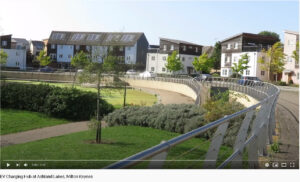In this blog entry we will discuss the selection of sites for deploying urban innovation (for example, for demonstrators, living-labs or technical trials), sharing some thoughts that arose in response to developments in a real-life project we are supporting. Our work in the project reminded us that site selection is not trivial- context matters for innovation experiments. Further developments provided us with a useful reminder about how perfection can only be found in theories- when it comes to real-world innovation projects, we are always optimising under constraints. But, as the King said to the white rabbit, we should begin at the beginning and go on till we come to the end. Below we will provide some background to the OSRIC project and discuss recent developments so that we can properly discuss the challenges of site selection.
In a previous blog post we introduced OSRIC (On-Street Residential Induction Charging) , a demonstrator for wireless charging points for electric vehicles. An important point is that Innovate UK has funded the demonstration of OSRIC wireless points in three locations : Milton Keynes, Buckinghamshire and the London Borough of Redbridge. Within each of the three locations one could find dozens of places where wireless charging points for EVs would be useful. As each site has a different context, the likely users of the wireless charging points and likely practices supported by them would be unique to each location. For instance, some places would be suitable for running a wireless EV car club and others would allow testing of a zero-carbon scheme for delivering supplies to people self-isolating because of the pandemic.

Faced with the challenge of identifying the sites with more potential to produce useful data, we produced a list of criteria for site selection which we developed for OSRIC but that are intended to be flexible enough as to be relevant to many other technology demonstrators. We have discussed the criteria in an earlier blog post.
The criteria are based on the principles of Strategic Niche Management so, broadly speaking, every potential site was assessed in terms of six main themes which where there unpacked in terms of various specific yes or no questions:
- Does the site meet project-specific performance criteria?
- Is the proposed application reasonably straightforward to set-up?
- Will we learn something useful from this site?
- Is a deployment at this site likely to help us connect with new organisations and institutions and develop our networks?
- Is the proposed project visible, exciting, and likely to help us make compelling and credible promises regarding the future of electric transport?
- Can we think of an exit strategy that will minimise potential end-of-project problems and increase the opportunities for positive follow-up activities?
As progress is being made on the technical side of OSRIC, certification and real-world deployment of the charging points is expected by the end of the year, making the issue of site selection somewhat urgent. To keep things simple this blog post will concentrate on recent site selection developments in Milton Keynes (MK) (Discussions of other places will follow in future blog posts)
The selection criteria were applied to 3 shortlisted sites in MK: Stony Stratford, Ashland Lakes and Caldecotte Lake. After engaging with local authorities to coordinate OSRIC strategy with the transport strategy for MK, it was decided that OSRIC site would simultaneously host a wireless e-car club and a wired charging hub providing 7kW and 50kW chargers for residents with no off-street parking (More information here).
A shortlist of locations where a hub and an e-car club could be suitably deployed was prepared, including the following locations:
- Stony Stratford, a dense town centre with a mix of commercial and residential areas;
- Ashland Lakes, a medium density residential area with limited off-street parking; and
- Caldecotte Lake, an attractive lakeside leisure area with amenities including a pub, a children’s play area with a miniature railway and an hotel.
(As an exercise, at this point I would like to ask readers to take a moment to reflect about the sites- If you were in charge of deploying an e-car club to demonstrate innovative wireless charging points, which one of the locations would you choose?)
When we applied the 25 criteria (covered in the previous blog) to the 3 locations, we rapidly concluded that Caldecotte Lake was not suitable . The charging hub would be useful to EV drivers visiting the lake, but there would not be a user base for a car club because there are not any residential areas within walking distance. With Caldecotte out of the running the choice came to either Stony Stratford or Ashland Lakes. According to the criteria, Stony Stratford had the upper hand. A deployment in a historic town centre with a mix of residential and commercial use and limited off-street parking would have been very pertinent to the goals of OSRIC.
However, it is at this point that the messy real world intervened and , in a way, we became victims of Milton Keynes’ success on the urban innovation front. Because MK has so many different urban experiments taking place at the same time, we found out that the site at Stony Stratford had also attracted the interest of a different consortium with funding from the Office for Low Emission Vehicles, which was also planning to demonstrate wireless charging points. Following some friendly conversations and some exploration regarding potential synergies between projects, we decided that organisationally it would make more sense to keep the demonstrators separate. Therefore, through a process of elimination, Ashland Lakes has become the leading candidate for the deployment of the wireless e-car club and residential charging hub combo.

Now, quickly coming back to the points outlined at the beginning of this post: Criteria based on innovation theories were very useful to inform our initial approaches to sites. In practice, however, innovation requires compromise. A framework can tell us what “perfect” looks like – a perfect user, a perfect practice or in this case a perfect site – but once we get to the real world, innovation is always about optimising under constraints. Paraphrasing the famous strategist Helmuth von Moltke: No plan will survive the first encounter with reality and “only a layman could suppose that the development of a campaign represents the strict application of a prior concept that had been worked out in every detail and followed through to the very end”. It is important to have a great objective continuously in mind, undisturbed by the vicissitude of events. A plan, in war or in innovation, will not last five minutes but it remains crucial to have one because when one is making decisions under fire in situations that cannot be foreseen, the plan offers a means to “ penetrating the uncertainty of veiled situations to evaluate the facts, clarify the unknown, make decisions rapidly, and then carrying them out with strength and constancy”.
In the case of OSRIC, having a list of criteria has helped us to remain focussed so, even as circumstances change, we can be committed to choosing the location and context that will provide a satisfactory level of information. The plan and the criteria not only informed the site selection but they also provide a sense of direction regarding the ultimate strategic goals of this innovation experiment. With Ashland Lakes we feel happy that this site will provide the sort of information OSRIC will need to get good user engagement and information on what difference wireless charging makes to their propensity to use EVs.
OSRIC is funded by InnovateUK and the Office for Low Emission Vehicles. The OU research team is led by Professor Matthew Cook; the Co-Investigator is Prof Stephen Potter and the Research Associate is Dr Alan-Miguel Valdez.

Leave a Reply